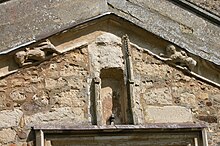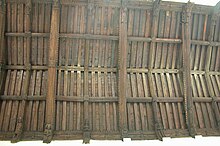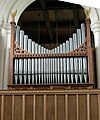All Saints Church (Wing)
The All Saints Church (All Saints) in Wing , Buckinghamshire is a parish church. Its masonry was largely erected in the 8th to 11th centuries during the Anglo-Saxon period . It is one of the oldest surviving churches in England.
location
Wing is 3 miles southwest of Leighton Buzzard and 12 miles northeast of Aylesbury . The church itself is located in the middle of a cemetery on the outskirts to the west of the town center.
First mention
The history of Wing goes back to the 7th or 8th century; the place name originally meant the settlement of Withuns people . The first missionaries appeared in the early second half of the seventh century and the region was Christianized from Aylesbury . The first mention of Wing comes from the period between 966 and 975. The first written mention of the church comes shortly after the Norman conquest in 1066 and concerns a priest named Goldric, who remained in possession of the churches and his land even after the Norman conquest.
The Anglo-Saxon Church
Remaining components from the Anglo-Saxon period are the apse and the crypt below , the north wall of the church and the pillars. It should be noted that the crypt and the apse above come from different building eras: the oldest part, three niches and windows in the crypt, are from the eighth century. The apse above dates from the ninth century and is one of the finest examples of ninth century architecture and the only fully preserved apse from the Anglo-Saxon period in England. The 10.6 meter high three-aisled church, with the exception of the outer wall of the south aisle, also dates from the Anglo-Saxon period. The triumphal arch between the apse and nave probably dates from the first renovation in the 9th century. The only Anglo-Saxon window is in the wall of the east gable above the choir.
From the Norman conquest to the Reformation
After the Norman conquest of England in 1066, the new landowner gave control of the church to the Benedictine monastery of St. Nicholas in Angers , possibly in the hope that the abbey in Wing would establish a priory. However, this was limited to employing a sexton and collecting the income yourself. From 1216, the endowment of the position of vicar of Wing was denied from the income of the church. From this time the church had the meaning of a parish church. In 1416, during the Hundred Years War between England and France , the church came to the priory of St. Mary des pres at St. Albans . From the middle of the 13th century to the end of the 15th century, the maintenance of the church was the responsibility of the secular lords of Wing and Ascott, who acted as patrons of the church.
Changes in the so-called Decorated Style experienced the church especially in the first half of the 14th century up to the plague year 1329. The largest building measures that changed the structure of the church took place in the 15th century in the Perpendicular Style . The most striking addition in the 15th century was the construction of the massive bell tower, a landmark that can be seen from a great distance. Six bells hang in the tower. Four of them date from the 17th century. They were cast between 1638 and 1654 by the Knight family's bell foundry in Reading. The oak bell cage dates from 1654.
Several stained glass windows date from the 14th century, including a coronation of Mary. The two entrance buildings in the south and north of the church as well as the portals on and in them date from the 14th and 15th centuries. The portals in the southern entrance are decorated with coats of arms, lions and other symbols associated with the patrons of the church. The font, which is still in use today, is also from the 15th century. The most important work of art that the 15th century left in the church is the wooden ceiling. Below the pediment are a number of excellently carved angels with outstretched wings. The edge of the ceiling is represented by a variety of figures such as B. kings, queens, musicians and devils adorned.
The Church in the Post-Reformation Period
The Reformation in England began around 1530 when Henry VIII separated the English Church from the papacy. The abolition of the monasteries was important for Wing, as in 1528 the Priory of St. Mary de Pre, to which Wing still belonged, was dissolved. The rights of the Priory were acquired by Robert Dormer, 1st Baron Dormer . The Dormers lived in the Ascott Hall country estate on the outskirts of Wing, acquired the title of Earl of Carnarvon in 1628 and were the most important Wing family until the beginning of the 18th century. Various members of the Dormer family are buried in the church, preferably at the eastern end of the north aisle. Particularly impressive are the tombs of Sir Robert Dormer († 1552), Sir William Dormer († 1575) with family and Robert Dormer, 1st Baron Dormer († 1616) with family.
The church houses a number of stained glass windows from the 19th century and a Walker organ from 1864, which was placed on a new gallery in the substructure of the tower in 2002.
literature
- Richard Gem, John Russel, Robert Hart: All Saints Church Wing . Ed .: Parish All Saints Church Wing. RJL Smith & Associates Much Ennlock Shropshire, 2003, ISBN 1-872665-69-1 (English).
Web links
Coordinates: 51 ° 53 ′ 41.5 ″ N , 0 ° 43 ′ 20 ″ W.








